1.5. CHEMICAL ENERGETICS
1/39
There's no tags or description
Looks like no tags are added yet.
Name | Mastery | Learn | Test | Matching | Spaced |
|---|
No study sessions yet.
40 Terms
What is the standard enthalpy change of atomisation (ΔHatꝋ)
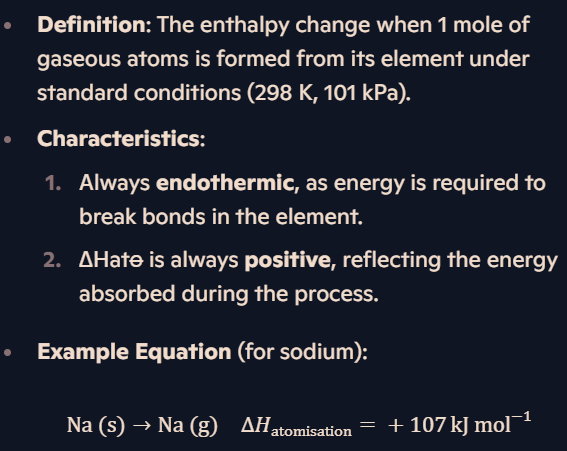
What is lattice energy (ΔHlattꝋ)?
Definition: The enthalpy change when 1 mole of an ionic compound is formed from its gaseous ions under standard conditions.
Characteristics:
Always exothermic, releasing a large amount of energy.
ΔHlattꝋ is negative due to energy release.
Indicates stability: more exothermic values mean stronger ionic bonds.
Example Equation:
Magnesium chloride:
Mg2+(g)+2Cl−(g)→MgCl2(s)
What is the first electron affinity (EA₁)?
Definition: The enthalpy change when 1 mole of electrons is added to 1 mole of gaseous atoms to form 1 mole of gaseous ions with a single negative charge.
Equation: X (g) + e−→X−(g)
Characteristics:
Usually exothermic due to energy release.
EA₁ values are typically negative.
What are the second and third electron affinities, and why are they different?
Definition:
EA₂ and EA₃ refer to adding subsequent electrons to negatively charged ions.
Equations:
Second Electron Affinity: X−(g)+e−→X2−(g)
Endothermic due to repulsion.
Third Electron Affinity: X2−(g)+e−→X3−(g)
Endothermic due to increased repulsion.
What factors affect the electron affinity (EA₁) of an element?
Nuclear Charge: Higher charge increases attraction for incoming electrons, making EA₁ more exothermic.
Distance: Greater distance between nucleus and added electron weakens attraction, making EA₁ less exothermic.
Shielding: More electron shells increase shielding, reducing attraction to incoming electrons, making EA₁ less exothermic.
What are the trends in electron affinity for Group 16 and 17 elements?
Across Periods: EA₁ becomes more exothermic with increasing nuclear charge (maximum at Group 17).
Down Groups:
EA₁ becomes less exothermic due to:
Larger atomic radius (greater distance from nucleus).
Increased shielding.
Exceptions:
Fluorine has lower EA₁ than chlorine due to high electron density causing repulsion.
Oxygen has lower EA₁ than sulfur for similar reasons.
Electron Affinity Table:
Group 16: O = –141, S = –200, Se = –195, Te = –190.
Group 17: F = –328, Cl = –345, Br = –325, I = –295.
Why are EA₂ and EA₃ endothermic?
Reason: Adding electrons to already negatively charged ions requires energy to overcome repulsion.
Result: Values are positive as energy is absorbed.
How do enthalpy change of atomisation and lattice energy relate to stability?
ΔHatꝋ: Indicates the energy required to produce gaseous atoms; affects how easily atoms can participate in bonding.
ΔHlattꝋ: Indicates the strength of ionic bonds in a lattice; more exothermic values show stronger bonds and greater stability of the ionic compound.
What is a Born-Haber cycle, and what is it used for?
Definition: A Born-Haber cycle is a thermodynamic energy cycle that applies Hess’s Law to ionic compounds. It visually represents energy changes in the formation of an ionic lattice, starting from its constituent elements.
Purpose:
Calculate lattice energy (ΔHlattꝋ): Lattice energy cannot be measured directly and is calculated using Hess’s Law through this cycle.
Understand stability: A more exothermic lattice energy implies stronger ionic bonds and greater stability of the ionic lattice.
Analyze enthalpy changes: Other changes like atomisation, ionisation energy, and formation are included in the cycle.
Key Principle: Energy levels increase as you move upward in the cycle, making visualization clear and organized.
What are the general steps in constructing a Born–Haber cycle for ionic solids?
Standard States: Start with the elements in their standard states at the bottom of the cycle (e.g., solid metal and diatomic non-metal gases).
Atomisation: Represent enthalpy changes when elements are converted to gaseous atoms (endothermic).
Ionisation and Electron Affinity:
Ionisation Energy: Energy required to remove electrons from gaseous atoms (endothermic).
Electron Affinity: Energy change when electrons are added to gaseous atoms (exothermic).
Formation: Show enthalpy of formation as the direct route, representing the formation of the ionic solid from the elements.
Lattice Energy: Represent lattice formation from gaseous ions, typically shown as highly exothermic.
How are calculations performed using a Born–Haber cycle?
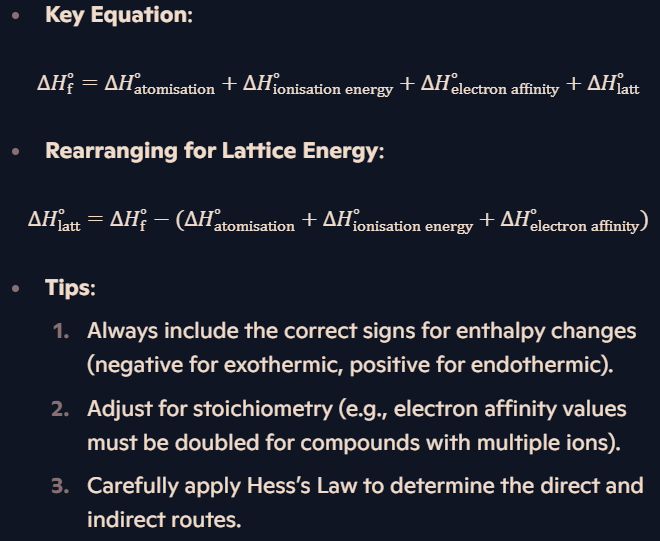
How does ionic charge affect lattice energy (ΔHlattꝋ)?
Effect of Ionic Charge:
Higher ionic charge → more exothermic lattice energy.
Greater charge density strengthens electrostatic attraction between ions.
Example:
CaO (formed from Ca²⁺ and O²⁻ ions) has a more exothermic ΔHlattꝋ than KCl (formed from K⁺ and Cl⁻ ions) due to stronger ionic bonds.
What are the factors that affect lattice energy (ΔHlattO)?
Ionic Radius:
Larger radius → Less exothermic lattice energy.
Larger ions have lower charge density and greater distances between ion centers, weakening electrostatic attraction.
Ionic Charge:
Higher ionic charge → More exothermic lattice energy.
Greater charge density strengthens electrostatic attraction between oppositely charged ions.
Why does increasing ionic radius result in less exothermic lattice energy?
Explanation:
The charge on larger ions is spread over a greater volume, reducing charge density.
Electrostatic forces between ions are weaker due to greater distance between ion centers in the lattice.
Result: Stability decreases, and less energy is released when the lattice forms.
Why does increasing ionic charge result in more exothermic lattice energy?
Explanation:
Higher ionic charge increases charge density, resulting in stronger electrostatic attractions.
Stronger attractions release more energy during lattice formation.
Result: Stability increases, and more energy is released when the lattice forms.
What general trends are observed in lattice energy across the periodic table?
Down a Group: Lattice energy becomes less exothermic as ionic radius increases.
Across a Period: Lattice energy becomes more exothermic as ionic charge increases and ionic radius decreases.
What are common challenges and tips for constructing and calculating Born–Haber cycles?
Challenges:
Incorrectly identifying endothermic (+) and exothermic (–) steps.
Forgetting stoichiometric adjustments (e.g., doubling electron affinity values for compounds with multiple ions).
Tips:
Label all steps and state symbols clearly.
Use brackets in calculations to ensure proper summation of values.
Draw arrows carefully to indicate endothermic (upward) and exothermic (downward) changes.
What is the enthalpy change of solution (ΔHsolθ)?
Definition: The enthalpy change when 1 mole of an ionic substance dissolves in sufficient water to form a very dilute solution.
Equation:
Ionic solid+aq→Ions in solution (aq)\text{Ionic solid} + \text{aq} \to \text{Ions in solution (aq)}
Characteristics:
ΔHsolθ can be exothermic (negative) or endothermic (positive).
Example: Dissolving potassium chloride:
KCl (s)+aq→K+(aq)+Cl−(aq)
What is the enthalpy change of hydration (ΔHhydθ)?
Definition: The enthalpy change when 1 mole of gaseous ions dissolves in sufficient water to form hydrated ions in a very dilute solution.
Equation: Ion (g)+aq→Ion (aq)
Characteristics:
Always exothermic, as energy is released when ion-dipole attractions form between ions and water molecules.
How do energy cycles involve ΔHsolθ, ΔHlattθ, and ΔHhydθ?
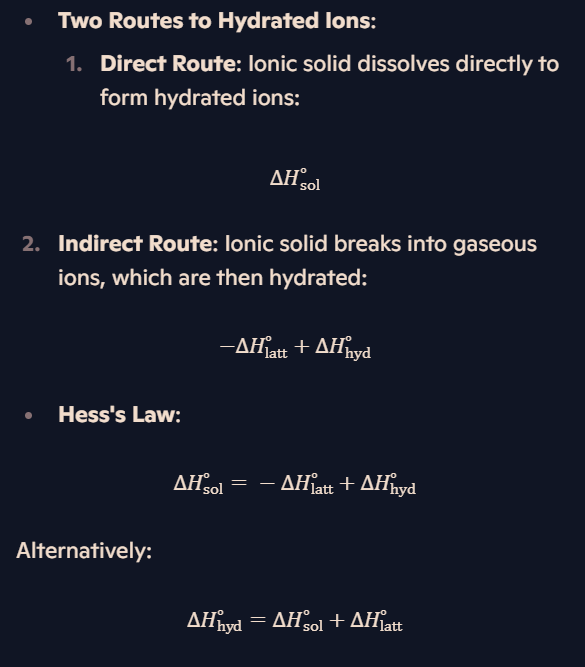
How are enthalpy change calculations carried out using energy cycles?
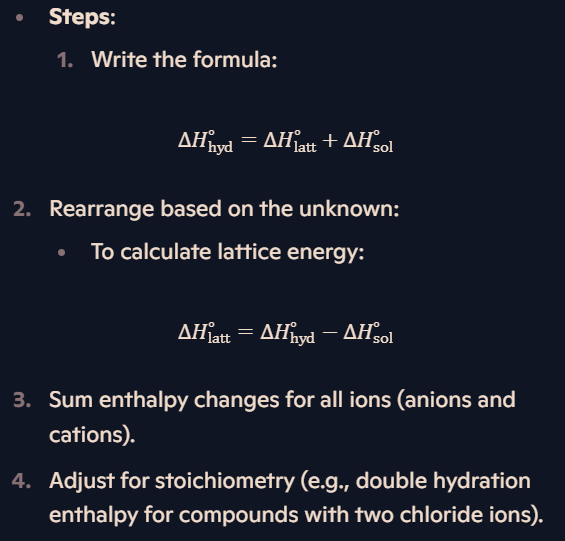
How does ionic radius affect the enthalpy change of hydration (ΔHhydθ)?
Effect: Smaller ionic radius → More exothermic ΔHhydθ.
Reason:
Smaller ions have higher charge density.
Stronger ion-dipole attractions form between ions and water molecules.
Greater energy is released during hydration.
How does ionic charge affect the enthalpy change of hydration (ΔHhydθ)?
Effect: Higher ionic charge → More exothermic ΔHhydθ.
Reason:
Ions with higher charges have greater charge density.
Stronger ion-dipole attractions form between ions and water molecules.
Greater energy is released when ions are hydrated.
What trends are observed in ΔHhydθ across the periodic table?
Ionic Radius:
Smaller ions (e.g., Group 1) have more exothermic ΔHhydθ than larger ions (e.g., Group 2).
Ionic Charge:
Higher charge ions (e.g., Ca²⁺, Mg²⁺) have more exothermic ΔHhydθ than singly charged ions (e.g., K⁺, Cl⁻).
Why must stoichiometric adjustments be made in enthalpy calculations?
Importance: Stoichiometry determines the number of ions involved.
Example:
For MgCl₂: Double the hydration enthalpy of Cl⁻ due to 2 moles of chloride ions forming per formula unit.
Why is ΔHhydθ always exothermic?
Reason: Formation of ion-dipole attractions between ions and polar water molecules releases energy.
Outcome: Energy released compensates for lattice energy absorbed during dissolution.
What is entropy (S)?
Definition: Entropy is the number of possible arrangements of particles and their energy in a given system.
Key Concept:
It is a measure of disorder in a system.
A system with higher entropy is more disordered and energetically more stable.
Example: In the decomposition of calcium carbonate:
CaCO3(s)→CaO (s)+CO2(g)
Gas formation (CO₂) increases disorder, leading to an entropy increase.
What factors affect entropy during changes in state?
Changes in State:
Melting (solid → liquid): Entropy increases as particles can move more freely.
H2O (s)→H2O (l)
Boiling (liquid → gas): Entropy increases significantly as particles are far apart and move freely.
Condensing (gas → liquid) and Freezing (liquid → solid): Entropy decreases as particles become more ordered.
Dissolving:
Solids dissolving in water increase entropy as particles become more disordered.
Crystallisation reduces entropy as particles become ordered in a lattice.
How does a temperature change affect entropy?
Increasing Temperature:
Particles vibrate more energetically, increasing disorder and entropy.
Decreasing Temperature:
Reduced particle motion decreases disorder and lowers entropy.
How do reactions involving gases affect entropy?
Increase in Gaseous Molecules:
Entropy increases as more gas molecules mean more possible arrangements.
Example: CaCO3(s)→CaO (s)+CO2(g)
Entropy increases as a solid produces gas.
Decrease in Gaseous Molecules:
Entropy decreases as the number of arrangements reduces.
Example: N2(g)+3H2(g)→2NH3(g)
Entropy decreases as 4 gas molecules become 2.
How is entropy change for a reaction (ΔS) calculated?
Formula: ΔS∘=ΣS∘(products)−ΣS∘(reactants)
Steps:
Multiply the entropy (S∘) of each product by its stoichiometric coefficient and sum the values.
Multiply the entropy (S∘) of each reactant by its stoichiometric coefficient and sum the values.
Subtract the total entropy of reactants from the total entropy of products.
Example: Reaction: N2(g)+3H2(g)→2NH3(g)
Calculation:
ΔS∘=(2×S∘(NH3))−(S∘(N2)+3×S∘(H2))
What is the Gibbs free energy equation, and what does it determine?
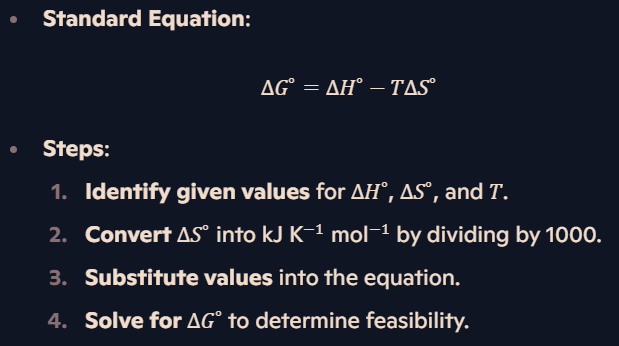
How does the sign of ΔG∘ determine reaction feasibility?
If ΔG∘<0→ Reaction is feasible and likely to occur.
If ΔG∘>0→ Reaction is not feasible and unlikely to occur.
How does temperature affect reaction feasibility?
Low Temperature (TT is small):
−TΔS∘ is small and has little impact on feasibility.
High Temperature (TT is large):
−TΔS∘ becomes more significant, making entropy a greater factor in feasibility.
How does temperature affect the feasibility of exothermic reactions (ΔH∘ is negative)?
If ΔS∘>0 (entropy increases):
Both terms in the Gibbs equation are negative.
Reaction is feasible at any temperature.
If ΔS∘<0 (entropy decreases):
At high temperatures, −TΔS∘ becomes large and positive, making ΔG∘ positive (reaction not feasible).
At low temperatures, −TΔS∘ is small, making ΔG∘ negative (reaction feasible).
How does temperature affect the feasibility of endothermic reactions (ΔH∘ is positive)?
If ΔS∘<0 (entropy decreases):
Both terms are positive.
Reaction is never feasible at any temperature.
If ΔS∘>0 (entropy increases):
At low temperatures, −TΔS∘ is small, making ΔG∘ positive (reaction not feasible).
At high temperatures, −TΔS∘ is large, making ΔG∘ negative (reaction feasible).
How does Le Chatelier’s principle relate to Gibbs free energy
Exothermic Reactions (ΔH∘ is negative):
Increasing temperature shifts equilibrium towards reactants, making the reaction less feasible.
Endothermic Reactions (ΔH∘ is positive):
Increasing temperature shifts equilibrium towards products, making the reaction more feasible.
How can the Gibbs equation be rearranged to find unknown values?
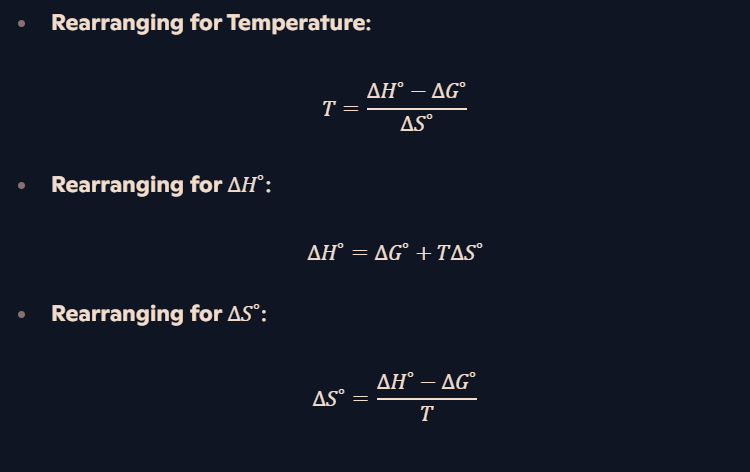
What key considerations should be made when calculating Gibbs free energy?
Ensure correct unit conversions (ΔS∘ must be divided by 1000).
Use Kelvin for temperature calculations (K = °C + 273).
Check signs (ΔH∘ is negative for exothermic reactions, positive for endothermic reactions).